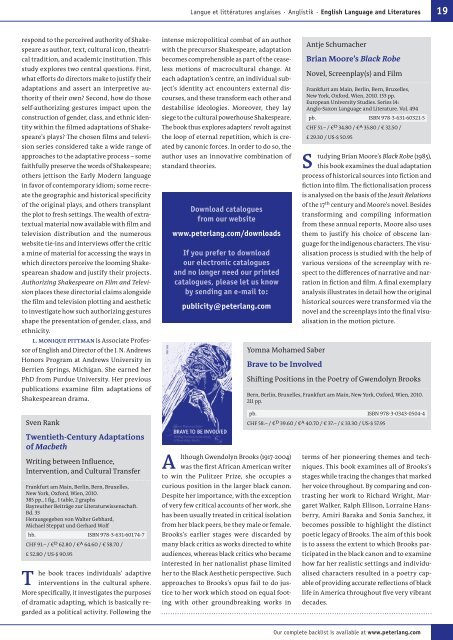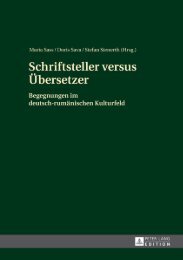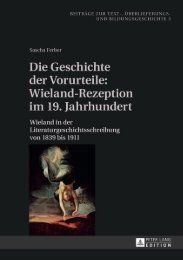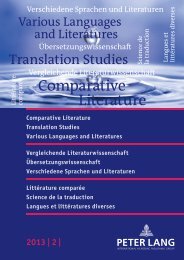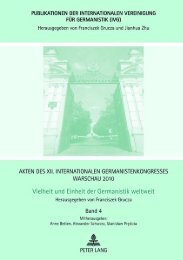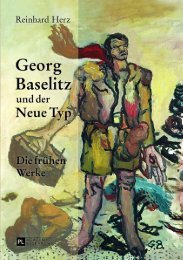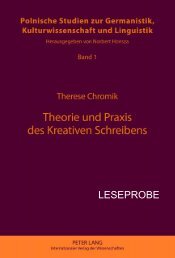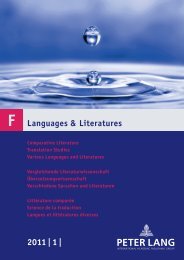Languages & Literatures 2011 | 1 | - Peter Lang
Languages & Literatures 2011 | 1 | - Peter Lang
Languages & Literatures 2011 | 1 | - Peter Lang
Create successful ePaper yourself
Turn your PDF publications into a flip-book with our unique Google optimized e-Paper software.
espond to the perceived authority of Shakespeare<br />
as author, text, cultural icon, theatrical<br />
tradition, and academic institution . This<br />
study explores two central questions . First,<br />
what efforts do directors make to justify their<br />
adaptations and assert an interpretive authority<br />
of their own? Second, how do those<br />
self-authorizing gestures impact upon the<br />
construction of gender, class, and ethnic identity<br />
within the filmed adaptations of Shakespeare’s<br />
plays? The chosen films and television<br />
series considered take a wide range of<br />
approaches to the adaptative process – some<br />
faithfully preserve the words of Shakespeare;<br />
others jettison the Early Modern language<br />
in favor of contemporary idiom; some recreate<br />
the geographic and historical specificity<br />
of the original plays, and others transplant<br />
the plot to fresh settings . The wealth of extratextual<br />
material now available with film and<br />
television distribution and the numerous<br />
website tie-ins and interviews offer the critic<br />
a mine of material for accessing the ways in<br />
which directors perceive the looming Shakespearean<br />
shadow and justify their projects .<br />
Authorizing Shakespeare on Film and Television<br />
places these directorial claims alongside<br />
the film and television plotting and aesthetic<br />
to investigate how such authorizing gestures<br />
shape the presentation of gender, class, and<br />
ethnicity .<br />
l. Monique PittMan is Associate Professor<br />
of English and Director of the J . N . Andrews<br />
Honors Program at Andrews University in<br />
Berrien Springs, Michigan . She earned her<br />
PhD from Purdue University . Her previous<br />
publications examine film adaptations of<br />
Shakespearean drama .<br />
Sven Rank<br />
Twentieth-Century Adaptations<br />
of Macbeth<br />
Writing between Influence,<br />
Intervention, and Cultural Transfer<br />
Frankfurt am Main, Berlin, Bern, Bruxelles,<br />
New York, Oxford, Wien, 2010 .<br />
385 pp ., 1 fig ., 1 table, 2 graphs<br />
Bayreuther Beiträge zur Literaturwissenschaft .<br />
Bd . 33<br />
Herausgegeben von Walter Gebhard,<br />
Michael Steppat und Gerhard Wolf<br />
hb . ISBN 978-3-631-60174-7<br />
CHF 91 .– / € D 62 .80 / € A 64 .60 / € 58 .70 /<br />
£ 52 .80 / US-$ 90 .95<br />
T<br />
he book traces individuals’ adaptive<br />
inter ventions in the cultural sphere .<br />
More specifically, it investigates the purposes<br />
of dramatic adapting, which is basically re-<br />
garded as a political activity . Following the<br />
<strong>Lang</strong>ue et littératures anglaises · Anglistik · English <strong>Lang</strong>uage and <strong>Literatures</strong><br />
intense micropolitical combat of an author<br />
with the precursor Shakespeare, adaptation<br />
becomes comprehensible as part of the ceaseless<br />
motions of macrocultural change . At<br />
each adaptation’s centre, an individual subject’s<br />
identity act encounters external discourses,<br />
and these transform each other and<br />
destabilise ideologies . Moreover, they lay<br />
siege to the cultural powerhouse Shakespeare .<br />
The book thus explores adapters’ revolt against<br />
the loop of eternal repetition, which is created<br />
by canonic forces . In order to do so, the<br />
author uses an innovative combination of<br />
standard theories .<br />
A<br />
Download catalogues<br />
from our website<br />
www.peterlang.com/downloads<br />
If you prefer to download<br />
our electronic catalogues<br />
and no longer need our printed<br />
catalogues, please let us know<br />
by sending an e-mail to:<br />
publicity@peterlang.com<br />
Yomna Mohamed Saber<br />
Brave to be Involved<br />
lthough Gwendolyn Brooks (1917-2004)<br />
was the first African American writer<br />
to win the Pulitzer Prize, she occupies a<br />
curious position in the larger black canon .<br />
Despite her importance, with the exception<br />
of very few critical accounts of her work, she<br />
has been usually treated in critical isolation<br />
from her black peers, be they male or female .<br />
Brooks’s earlier stages were discarded by<br />
many black critics as works directed to white<br />
audiences, whereas black critics who became<br />
interested in her nationalist phase limited<br />
her to the Black Aesthetic perspective . Such<br />
approaches to Brooks’s opus fail to do jus-<br />
tice to her work which stood on equal foot-<br />
ing with other groundbreaking works in<br />
Antje Schumacher<br />
Brian Moore’s Black Robe<br />
Novel, Screenplay(s) and Film<br />
Frankfurt am Main, Berlin, Bern, Bruxelles,<br />
New York, Oxford, Wien, 2010 . 153 pp .<br />
European University Studies . Series 14:<br />
Anglo-Saxon <strong>Lang</strong>uage and Literature . Vol . 494<br />
pb . ISBN 978-3-631-60321-5<br />
CHF 51 .– / € D 34 .80 / € A 35 .80 / € 32 .50 /<br />
£ 29 .30 / US-$ 50 .95<br />
S<br />
tudying Brian Moore’s Black Robe (1985),<br />
this book examines the dual adaptation<br />
process of historical sources into fiction and<br />
fiction into film . The fictionalisation process<br />
is analysed on the basis of the Jesuit Relations<br />
of the 17th century and Moore’s novel . Besides<br />
transforming and compiling information<br />
from these annual reports, Moore also uses<br />
them to justify his choice of obscene language<br />
for the indigenous characters . The visualisation<br />
process is studied with the help of<br />
various versions of the screenplay with respect<br />
to the differences of narrative and narration<br />
in fiction and film . A final exemplary<br />
analysis illustrates in detail how the original<br />
historical sources were transformed via the<br />
novel and the screenplays into the final visualisation<br />
in the motion picture .<br />
Shifting Positions in the Poetry of Gwendolyn Brooks<br />
Bern, Berlin, Bruxelles, Frankfurt am Main, New York, Oxford, Wien, 2010 .<br />
211 pp .<br />
pb . ISBN 978-3-0343-0504-4<br />
CHF 58 .– / € D 39 .60 / € A 40 .70 / € 37 .– / £ 33 .30 / US-$ 57 .95<br />
terms of her pioneering themes and tech-<br />
niques . This book examines all of Brooks’s<br />
stages while tracing the changes that marked<br />
her voice throughout . By comparing and con-<br />
trasting her work to Richard Wright, Mar-<br />
garet Walker, Ralph Ellison, Lorraine Hans-<br />
berry, Amiri Baraka and Sonia Sanchez, it<br />
becomes possible to highlight the distinct<br />
poetic legacy of Brooks . The aim of this book<br />
is to assess the extent to which Brooks participated<br />
in the black canon and to examine<br />
how far her realistic settings and individualised<br />
characters resulted in a poetry capable<br />
of providing accurate reflections of black<br />
life in America throughout five very vibrant<br />
decades .<br />
Our complete backlist is available at www.peterlang.com<br />
19


